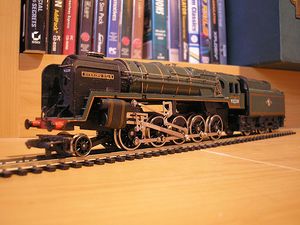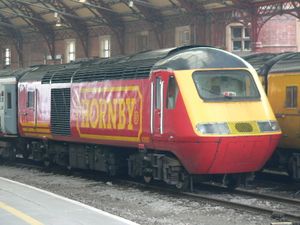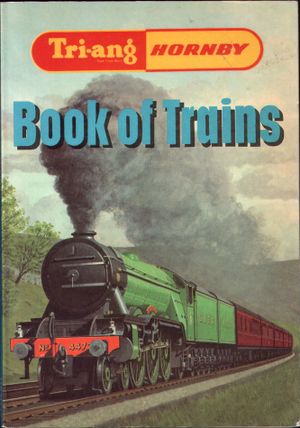Hornby Railways
Hornby Railways is the leading brand of model railway in the United Kingdom, and its company roots date back to 1901, when founder Frank Hornby received a patent for his Meccano construction toy.
Early history
Hornby, then known as Meccano Ltd and based in Liverpool, released its first train, a clockwork O gauge model, in 1920. An electric train soon followed but was under-designed and the few that were made were sold out in France. In 1925 a much more successful electric model was introduced , operating on high voltage (220-240V) AC power, safety concerns saw low voltage 4 volt and then 6 volt motors introduced, followed by a reliable 20 volt AC system, which was developed in the early 30s. However, clockwork remained the mainstay of the Hornby 'Series' 0 gauge trains until 1937, and became the only power available to Liverpool made 0 gauge from 1949.
A separate factory was established in France that developed its own range of French outline trains, but Liverpool dominated export activity elsewhere, large numbers of Hornby trains were exported to Australia, New Zealand, Argentina and Scandinavia. Even though the export models were often painted in 'foreign' liveries Hornby Trains looked very British. Hornby attempted to break into the American Market by setting up a factory in 1927 in Elizabeth, New Jersey, to make specifically American style trains. These were colourful and attractive, but low market and only clockwork. They probably would have failed in the marketplace because several established U.S. firms could undercut them and Hornby offered no better-class goods or electric models, but the Wall Street Crash precipitated matters. In late 1929, Meccano Ltd. sold its New Jersey factory to the A. C. Gilbert Company, and Hornby trains had vanished from the U.S. market by 1930. The leftover inventory was sold in Canada and in the UK, and some of the tooling was reused for products in other markets.
Hornby Dublo
Hornby introduced its OO gauge trains in 1938, under the trade name 'Hornby Dublo'. The locomotives were die-cast, and the cars were generally made of tinplate. This was a very well planned range dominated by electric models and successfully consolidating 12 volt direct current as THE standard for 00/H0 scale. The range expanded quickly, but was curtailed from 1940 due to World War II, production being completely suspended in 1942. Production resumed after the war but did not reach full capacity until 1948. A Hornby Dublo layout
Like its counterparts Bassett-Lowke and Exley in the UK and Lionel and American Flyer in the US, Hornby thrived in the first half of the decade but struggled in the late 1950s. The company were slow to recognise the threat posed by rival manufacturers (particularly Triang-Rovex) and to realise the potential of plastic. In 1959, far too late, Hornby introduced two-rail track, even then, the system was complicated and difficult to use in comparison to its rivals. Meanwhile the company plugged on producing a range of very old-fashioned 0 gauge models, in 1957 completely retooling much of the range instead of taking the opportunity to discontinue it, indicative of major failings at management level.
Merger with Tri-ang
In 1964, the parent company of rival Tri-ang Railways purchased Meccano Ltd. and merged Hornby and Tri-ang into Tri-ang Hornby. The former Hornby line was discontinued in favour of Tri-ang's less costly plastic designs. The former Hornby Dublo tooling was sold to G & R Wrenn which continued to make most of the loco range and 'superdetail' rolling stock. Remaining stocks of 0 gauge were either scrapped or sold to the local retailer Hattons. In 1967 Hornby was merged internally into Rovex Industries, which by 1969 was Rovex Tri-ang Ltd.
The Tri-ang group was disbanded in 1971 when Meccano Ltd's owner Lines Bros. filed for bankruptcy. The former Tri-ang Hornby was sold to Dunbee-Combex-Marx becoming Hornby Railways in 1972. By 1976 Hornby was facing challenges from Palitoy and Airfix both of whom were producing high quality detailed models. Detail on the models was upgraded to make the product line more attractive to adult hobbyists. A multiple train control system named Zero 1 was introduced in the early 1980s. This digital system was a forerunner to the Digital Command Control (DCC) system, an NMRA open standard, which appeared in the 1990s.
By 1980 the market was extremely tough and Dunbee-Combex-Marx was liquidated placing Rovex in receivership. In 1980 Hornby became ""Hornby Hobbies"" and in 1981 a management buyout saw the company back on a sound footing. It went public in 1986.


By the early 1990s Hornby again faced competition from newcomers like Dapol and established foreign manufacturers including Lima and Bachmann Industries. Manufacturing was moved to Guangdong province in China in 1995, and was complete by 1999, cutting costs and improving quality according to the company. As part of the process Hornby also bought in some of Dapol's products and also some of the old Airfix moulds (by then owned by Dapol). Train sets associated with Thomas the Tank Engine and Friends, and Harry Potter (the "Hogwarts Express") have been particularly profitable ventures. In September 2003 Hornby released its first steam-powered OO gauge locomotive, a model of the record-breaking Mallard. Several other "Live Steam" locomotives have now been produced.
Since then, Hornby has bought Lima, an Italian model railway equipment manufacturer that previously acquired Jouef, a French manufacturer. Its items have yet to be integrated into the main Hornby products list.
Hornby now produces a large range of detailed locomotives, such as the new class 60,50,31 and 08.
Hornby Midland Mainline HST with 8 Coaches
References
- Schneider, Lewis (May 2000). Hornby's Made in USA Trains. Classic Toy Trains, page 84.


